Diptera.info :: Family forums :: Asilidae Forum
|
Neomochtherus sp. female
|
|
| Armen Seropian |
Posted on 13-07-2019 18:57
|
|
Member Location: Georgia, Tbilisi Posts: 391 Joined: 21.03.16 |
Rep.of Georgia, Gori, female. Can anyone determine the species? 
Armen Seropian attached the following image: 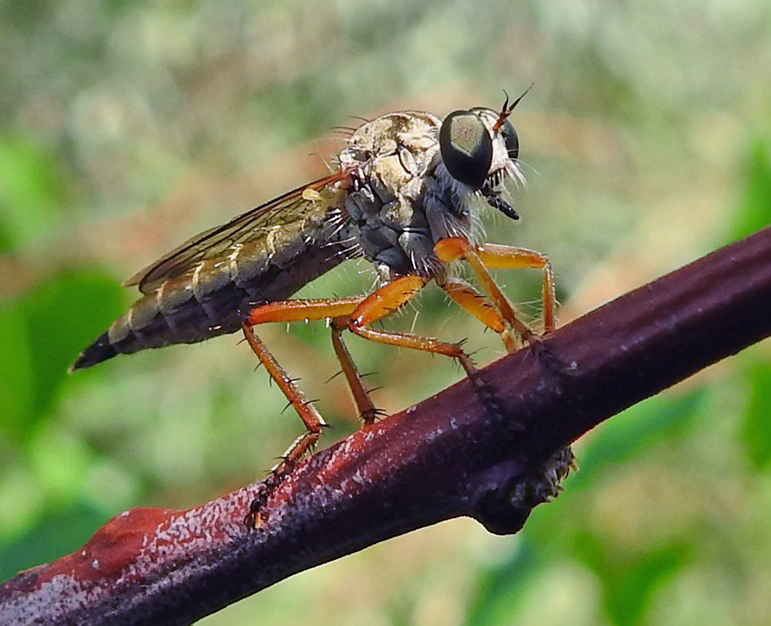 [264.42Kb] |
|
|
|
| Armen Seropian |
Posted on 13-07-2019 18:58
|
|
Member Location: Georgia, Tbilisi Posts: 391 Joined: 21.03.16 |
Neomochtherus sp. female
Armen Seropian attached the following image: 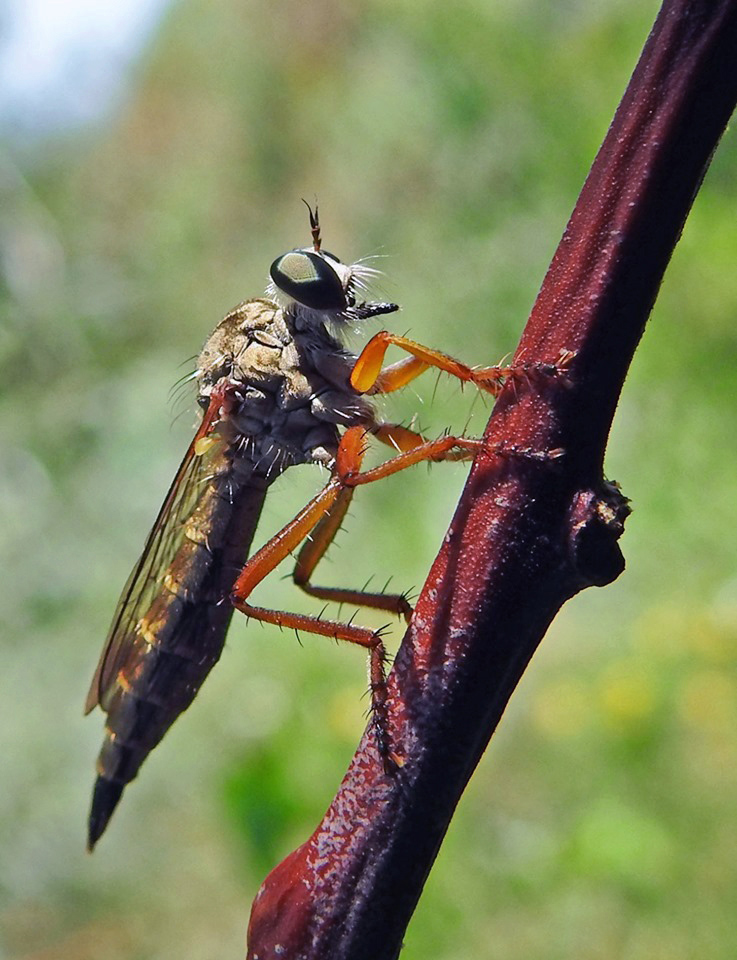 [268.45Kb] |
|
|
|
| Armen Seropian |
Posted on 22-07-2019 18:39
|
|
Member Location: Georgia, Tbilisi Posts: 391 Joined: 21.03.16 |
So here are few more pics of the same species, but now of both sexes. I've excluded N. denticulatus, N. flavipes, N. mundus, N. nairicus, N. perplexus and N. urartorum (considering the data given in Richter's "Asilidae of Caucasus", so the only to species left are N. desertorum and N. manni. Also I've started translating the key given in book mentioned above and the 3 species given below are all for now (sorry for non-professional translation of some terminology). 1.Neomochtherus denticulatus Face, vertex and the posterior surface of head are covered with dense silver-white or golden-yellow dust; laterally vertex is covered with black and white hair; distance between facial gibbosity is and antennae base is a bit less, then the total length of antennae 2 basal segments; facial beard consists of white pubescences, with a mixture of several black pubescences along its upper edge; palpus black, covered with white pubescences; antennae black or dark brown; their basal segments covered in grey dust and white and black setae and pubescences; 3-d antennal segment length < two basal segments total length; arista length equals ¾ length of 3-d segment. Mesonotum covered in yellow-greyish dust, covered with short standing black and white hair; median brown stripe reaches the posterior edge of mesonotum, and is separated with broad grey line reaching the transverse suture of mesonotum; the lateral brown stripe is divided into two spots by grey stripe crossing along the transverse suture; mesonotum hair white or with a mixture of several black pubescences. Legs with adjacent short white and black hair and black and white setae; femur black or with posterior ventral yellow stripe; tibiae yellow, with more or less darkened apex; front tibia with very long, thin bristles; tarsus black, first segment is brownish yellow; claws black with reddish yellow base. Wings transparent; medial transverse vein immediately behind the middle of the discoid cell. Abdomen covered with grey dust, short adjacent white hair and white bristles; 8-th sternite of male is brownish-black, shiny, laterally covered in dust. Hypopygium brownish-black, with white hair; both halves of the epandrium on top of the medial edge with weakly sclerotized processes, in front of the apex with a rounded lobe-like outgrowth, at the apex elongated into a long narrow process, intersecting with the symmetric process of the other half of the epandrium. Ovipositor black and shiny; its length exceeds the length of the two preceding segments of the abdomen combined. Body length – 7-12 mm. 2.Neomochtherus desertorum Face, frons, vertex and the posterior surface of head covered with dense silver-greyish dust; laterally frons is covered with white hair; occiput covered with white hair; antennae basal segments reddish-yellow; 3-d antennal segment with arista dark-brown or black. Mesonotum covered in yellow-greyish dense dust, with short white hair with a mixture of black ones; median brown stripe reaches over the posterior edge of mesonotum, but doesn’t reach scutellum; lateral and dorsomedial bristles are white; scutellum in grey dust and with thin white hair. Legs yellow, with black and white thin hair and firm setae; apex of tibia and each tarsal segment sometimes dark brown. Wings transparent or a bit yellowish; medial transverse vein located behind the middle of the discoid cell. Abdomen covered with dense yellow-greyish dust, tergites with short adjacent white hair and with white bristles laterally; sternites with long white protruding hair. Hypopygium black and shiny, with white and black hair; both halves of the epandrium on top with yellow narrow process, intersecting with the symmetric process of the other half of the epandrium. Ovipositor black; its length exceeds the length of the two preceding segments of the abdomen combined. Body length – 10-14 mm. The indication of presence in the Caucasus is based on the definition of signle female and needs to be confirmed. 3.Neomochtherus flavipes Face, frons, vertex and the posterior surface of head covered with dense yellow-whitish dust; facial beard bristles, occiput bristles and “whiskers” are white or yellow-whitish; palpus black with white hair; antennae black, its basal segment covered with black hair. Mesonotum covered in yellow-greyish dense dust, short black hair; median brown stripe reaches over the posterior suture of pronotum, but doesn’t reach it’s hind edge; in the front half divided with wide grey line; lateral and dorsomedial bristles are yellow-whitish, sometimes with black ones; scutellum in grey dust, with 2 white bristles at the hind edge. Legs yellow, with black thin hair and black and white firm setae; femur from the anterior transdorsal side with a longitudinal wide black band, usually not reaching their apex and base; apex of tibia and each tarsal segment is black; claws black, with red-yellowish base. Wings transparent, a bit yellowish; medial transverse vein located behind the middle of the discoid cell. Abdomen covered in grey dust and short adjacent hait, tergites with white lateral bristles; 1-st and 2-nd sternites with long white protruding hair; subsequent sternites bear firm bristles. Hypopygium yello-reddish, with white and black hair; both halves of the epandrium on top without narrow processes, with white lamellar short projection. Ovipositor brown-blackish; its length exceeds the length of the two preceding segments of the abdomen combined; 8-th tergite in the anterior third strongly convex, not squeezed laterally, brownish-red Body length – 12-23 mm.          
Edited by Armen Seropian on 22-07-2019 18:57 |
|
|
|
| Quaedfliegh |
Posted on 24-07-2019 21:20
|
|
Member Location: Tilburg Netherlands Posts: 2225 Joined: 18.05.10 |
Please go on translating!!!!! Thank you :-) I do not want to make things more difficult but genus has been devided some more by Lehr in 1996 genus like Aneomochtherus named after N. asiaticus. Very often, if not all of the time you need males to ID the species Greetings, Reinoud Field guide to the robber flies of the Netherlands and Belgium: https://www.jeugdbondsuitgeverij.nl/product/field-guide-to-the-robberflies-of-the-netherlands-and-belgium/ https://www.nev.nl/diptera/ |
| Armen Seropian |
Posted on 27-07-2019 12:27
|
|
Member Location: Georgia, Tbilisi Posts: 391 Joined: 21.03.16 |
Quaedfliegh wrote: Please go on translating!!!!! Thank you :-) I do not want to make things more difficult but genus has been devided some more by Lehr in 1996 genus like Aneomochtherus named after N. asiaticus. Very often, if not all of the time you need males to ID the species There's a pic of male above (unfortunately not the clearest one). As for the translation, it takes time  Here comes the fourth species from the monograph. If needed, I'll attach drawings of genitalia from it a bit later. Here comes the fourth species from the monograph. If needed, I'll attach drawings of genitalia from it a bit later.4. Neomochtherus manni (accepted name - Cerdistus manni) Face, frons and vertex covered with dense yellow-whitish dust; posterior part of head covered with silver-whitish dust; frons laterally with short white and black hair; ocellar bristles short and black; distance between facial gibbosity and antennae base equals the total length of antennae 2 basal segments; facial beard consists of white bristles with some black ones on its upper margin; palpus brown-blackish with white hair; occiput and“whiskers”with white bristles; antennae brown-blackish, first two basal segments with light-silver dust and black hair; 3-rd segment shorter then total length of two basal segments; arista longer then third segment. Mesonotum in grey dense dust, short white and black hair; mesonotum bristles white and black. Legs yellow, with black and white hair and long bristles; femur from the anterior side with a more or less well developed wide black band; claws black, with yellow base. Wings transparent, a bit yellowish; medial transverse vein located above the middle of the discoid cell. Tergites medially in yellowish dust and short black hair, laterally in grey dust, white hairs and bristles; sternites in grey dust and white hairs; with white lateral bristles; male’s 8-th sternite with straight hind margin. Hypopygium yellow-reddish; both halves of the epandrium covered in black hairs; in the middle of the medial margin with two thin protrusions in front of the apex, on the top also with a rounded lamellar projection. Body length – 9 mm. Distribution: Transcaucasia, Asia Minor Armen Seropian attached the following image: 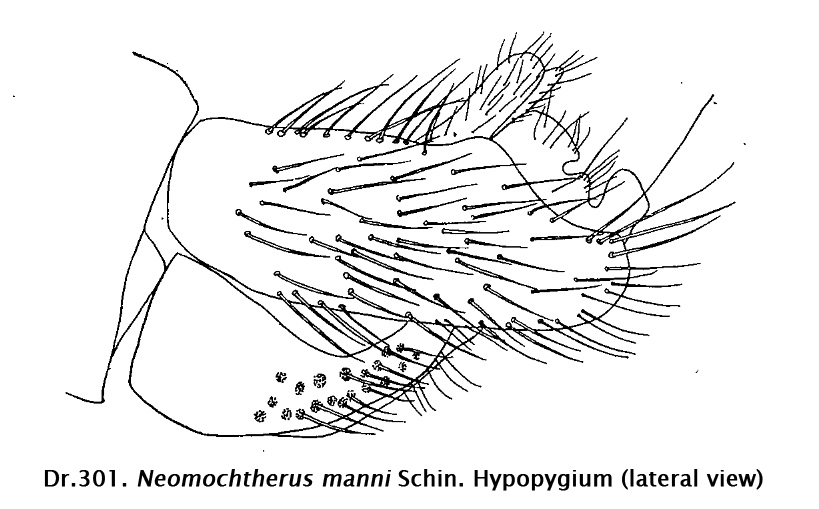 [119.61Kb] Edited by Armen Seropian on 28-07-2019 17:38 |
|
|
|
| Armen Seropian |
Posted on 27-07-2019 13:19
|
|
Member Location: Georgia, Tbilisi Posts: 391 Joined: 21.03.16 |
5. Neomochtherus mundus Face, frons, vertex and and the posterior surface of head covered in dense yellow dust; head’s bristles and hair completely white; palpus black with short white hairs and bristles; antennae black with short black and white hairs and bristles on it’s basal segments.. Mesonotum in dense light grey dust, short white and black hair; median brown stripe ends at the posterior suture of mesonotum; mesonotum bristles yellow-whitish with some black bristles; scutellum in dense grey dust, with pair of yellow-whitish bristles at the hind margin. Legs yellow, with white hair and bristles; leg 1 and 2 femur from the anterior side with wide black band; leg 3 femur posteriorly with thin yellow band; tibia yellow, apically black; tarsus brown-blackish; claws black, with red-yellowish base. Wings transparent; medial transverse vein located behind the middle of the discoid cell. Abdomen in light grey dust, white hairs and bristles; 1-st sternite with longs white hairs. Hypopygium yellow-reddish or red-brownish, with white hairs; both halves of the epandrium in the middle with wide triangular lamellar outgrowth, ventrally elongated at the top in a narrow short process; basal segment of gonopods long and narrow, curved; hypandrium with a wide and deep cut at the rear margin. Ovipositor black; its length equals the length of the two preceding segments of the abdomen combined. Body length – 14-20 mm. Distribution: Transcaucasia, Kazakhstan, Asia Middle, Greece, north China Edited by Armen Seropian on 27-07-2019 15:34 |
|
|
|
| Quaedfliegh |
Posted on 27-07-2019 16:28
|
|
Member Location: Tilburg Netherlands Posts: 2225 Joined: 18.05.10 |
In this translation you mention N. denticulatus. Shouldn't that be Cerdistus denticulatus? Could you also mention the author of the species? Systema Dipterorum doesn't know know Neomochtherus denticulatus.
Greetings, Reinoud Field guide to the robber flies of the Netherlands and Belgium: https://www.jeugdbondsuitgeverij.nl/product/field-guide-to-the-robberflies-of-the-netherlands-and-belgium/ https://www.nev.nl/diptera/ |
| Armen Seropian |
Posted on 27-07-2019 16:51
|
|
Member Location: Georgia, Tbilisi Posts: 391 Joined: 21.03.16 |
Quaedfliegh wrote: In this translation you mention N. denticulatus. Shouldn't that be Cerdistus denticulatus? Could you also mention the author of the species? Systema Dipterorum doesn't know know Neomochtherus denticulatus. N. dencitulatus, Loew 6. Neomochtherus nairicus Face, frons, vertex and and the posterior surface of head covered in dense silver-whitish dust; vertex lateral hairs and ocelli bristles white; occipital bristles, facial beard bristles and “whiskers” white; palpus black with white hairs; antennae basal segments yellow, with light dust and white hairs; 3-d segment and arista black; its length almost equals total length of two basal segments; arista a bit shorter then third segment. Mesonotum in yellow-whitish dust, short white and black hair; median brown stripe longitudinally divided by a narrow gray-dusted stripe, ends after the transverse suture of mesonotum; mesonotum with white and black bristles; dorsocentral bristles do not extend beyond transverse suture; scutellum in grey dust and quit dense white hairs, with pair of yellow-whitish bristles at the hind margin. Femur completely black or with a yellow band, covering its hind and ventral surfaces; tibia yellow, anteriorly with dark band and more or less darkened apical part; tarsus brown-blackish. Wings transparent; medial transverse vein located behind the middle of the discoid cell. Abdomen in silver-greyish dust and white hairs (males tergites with black hairs); tergites laterally with white bristles; 1-st sternite with long white hairs. Hypopygium with dense white hairs; epandrium, except for the top, cerci and basal segments of gonopods dark brown; epandrium apical parts and distal segments yellow-reddish; both halves of the epandrium from above along the distal edge in front of the apex with an elongated triangular lamellar process, at the apex along the lower edge with a cylindrical process. Ovipositor brown-yellowish; its length is more then the length of the two preceding tergites combined. Body length – 12-14 mm. Ecology: known from central Aras valley deserts. Distribution: Transcaucasia Armen Seropian attached the following image: 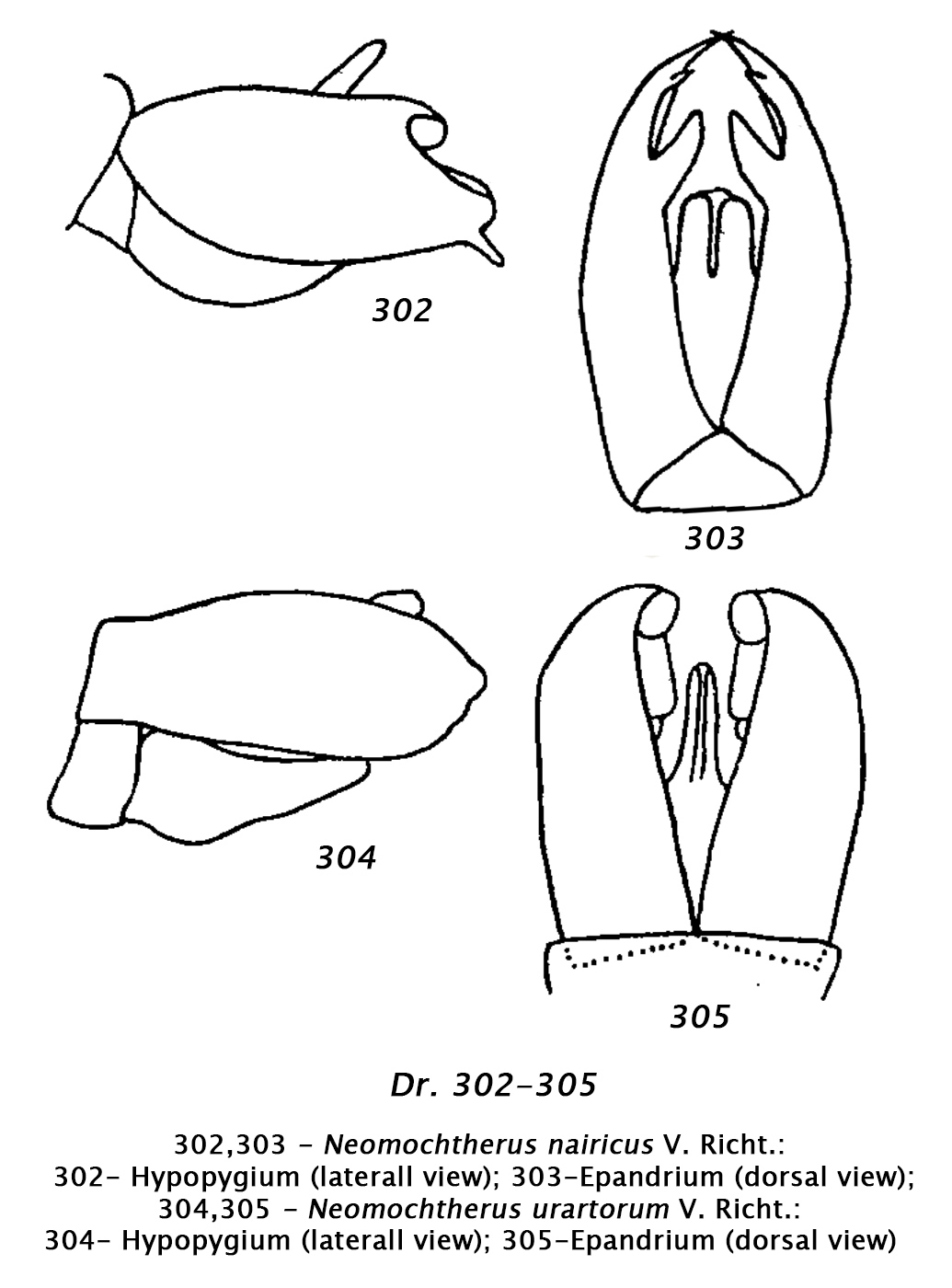 [207.36Kb] Edited by Armen Seropian on 27-07-2019 16:56 |
|
|
|
| Quaedfliegh |
Posted on 27-07-2019 17:22
|
|
Member Location: Tilburg Netherlands Posts: 2225 Joined: 18.05.10 |
Thank you, but than N denticulatus = Cerdistus denticulatis. Could you tell me from which year the Work by Richter is?
Greetings, Reinoud Field guide to the robber flies of the Netherlands and Belgium: https://www.jeugdbondsuitgeverij.nl/product/field-guide-to-the-robberflies-of-the-netherlands-and-belgium/ https://www.nev.nl/diptera/ |
| Armen Seropian |
Posted on 27-07-2019 18:58
|
|
Member Location: Georgia, Tbilisi Posts: 391 Joined: 21.03.16 |
Quaedfliegh wrote: Thank you, but than N denticulatus = Cerdistus denticulatis. Could you tell me from which year the Work by Richter is? Great!  The work is published in 1968. The work is published in 1968.7. Neomochtherus perplexus Face, frons, vertex and and the posterior surface of head covered in dense silver-greyish or yellow-whitish dust; head bristles white or yellow, only eyes bristles sometimes black; palpus black with white hair; antennae basal segments red-yellowish or black; 3-d segment and arista black; its length is less then total length of two basal segments; arista longer then third segment. Mesonotum in dense yellow-whitish dust, short white and black hair; median brown stripe divided by a narrow grey-dusted stripe, ends after the transverse suture of mesonotum; mesonotum with white or white and black bristles; dorsocentral bristles do not extend beyond transverse suture; scutellum in dense grey dust and sparse white hair. Legs yellow, with white and black hair and firm bristles; anteriorly femur usually with longitudinal black stripe; tibia yellow, sometimes apically darkened; tarsus 1-st segment yellow, apically darkened; subsequent segments brown-blackish; claws black with reddish base. Wings transparent or brownish; medial transverse vein located behind or above the middle of the discoid cell. Abdomen in grey dust; tergites with short white and black hair and laterally white bristles; 1-st and 2-nd sternites with thin long white hair, subsequent sternites with firm white bristles. Hypopygium black with black and white hair; both halves of the epandrium along the medial margin in front of the apex with two protrusions arranged one after the other, the protrusion located immediately in front of the apex is semicircularly cut along the edge; on the top, each half of the epandrium is elongated into a narrow process, intersecting with the symmetric process of the other half; basal segment of gonopod wide at base, strongly narrowed to apex, at the middle of medial margin with medially directed long black bristles; gonopod distal segment yellow, long, curved, not constricted at the apex, slightly cut in the middle of the apical margin; its inner surface at the top is covered with protruding black hair. Ovipositor black or red-brownish; its length equals the length of the two preceding tergites combined; the ventral surface of the ventral plate in the long thin hairs. Body length – 16-24 mm. Ecology: Marked for the steppe and desert landscapes of eastern Transcaucasia and the middle Aras valley. Distribution: South and southeast of the European part of the USSR, the Caucasus, Kazakhstan, Central Asia, Hungary, northern China, eastern Mongolia Edited by Armen Seropian on 27-07-2019 19:02 |
|
|
|
| Armen Seropian |
Posted on 27-07-2019 19:23
|
|
Member Location: Georgia, Tbilisi Posts: 391 Joined: 21.03.16 |
And the last one. I wonder, if that helps with identification of the depicted above robber fly  8. Neomochtherus urartorum Face, frons, vertex and the posterior surface of head covered in dense silver-whitish dust; occipital bristles, facial gibbosity bristles and “whiskers” are white; antennae basal segments yellow, covered with white and black hair; 3-d segment and arista black; its length is a bit less then the total length of two basal segments; arista longer then third segment. Mesonotum in grey-yellowish dust, short black hair; hair after the transverse suture longer and white; median brown stripe reaches the scutellum, divided throughout its length by a narrow longitudinal strip of grey dust; scutellum with dense white hair. Legs yellow, with white and black hair and bristles;; tarsus yellow, apically darkened or entirely dark brown. Wings transparent; medial transverse vein located behind the middle of the discoid cell. Abdomen in light grey dust and white hair; tergites marginal bristles also white. Hypopygium red-brownish, with dense white hair; both halves of the epandrium from above in front of the apex with elongated rectangular lamellar platforms; gonopod basal segment elongated; distal segment of gonopod narrow, curved towards apex. Ovipositor red-brownish, shiny; its length exceeds the length of the two preceding tergites combined. Body length – 15-16 mm. Ecology: The species is found in the deserts and slopes covered with upland xerophytic vegetation of middle Aras valley. Host: Euchorthppus pulvinatus, Hephathus sp., Euscelis plebejus, Microgaster sp., Nomioides sp. Distribution: Transcaucasia Armen Seropian attached the following image: 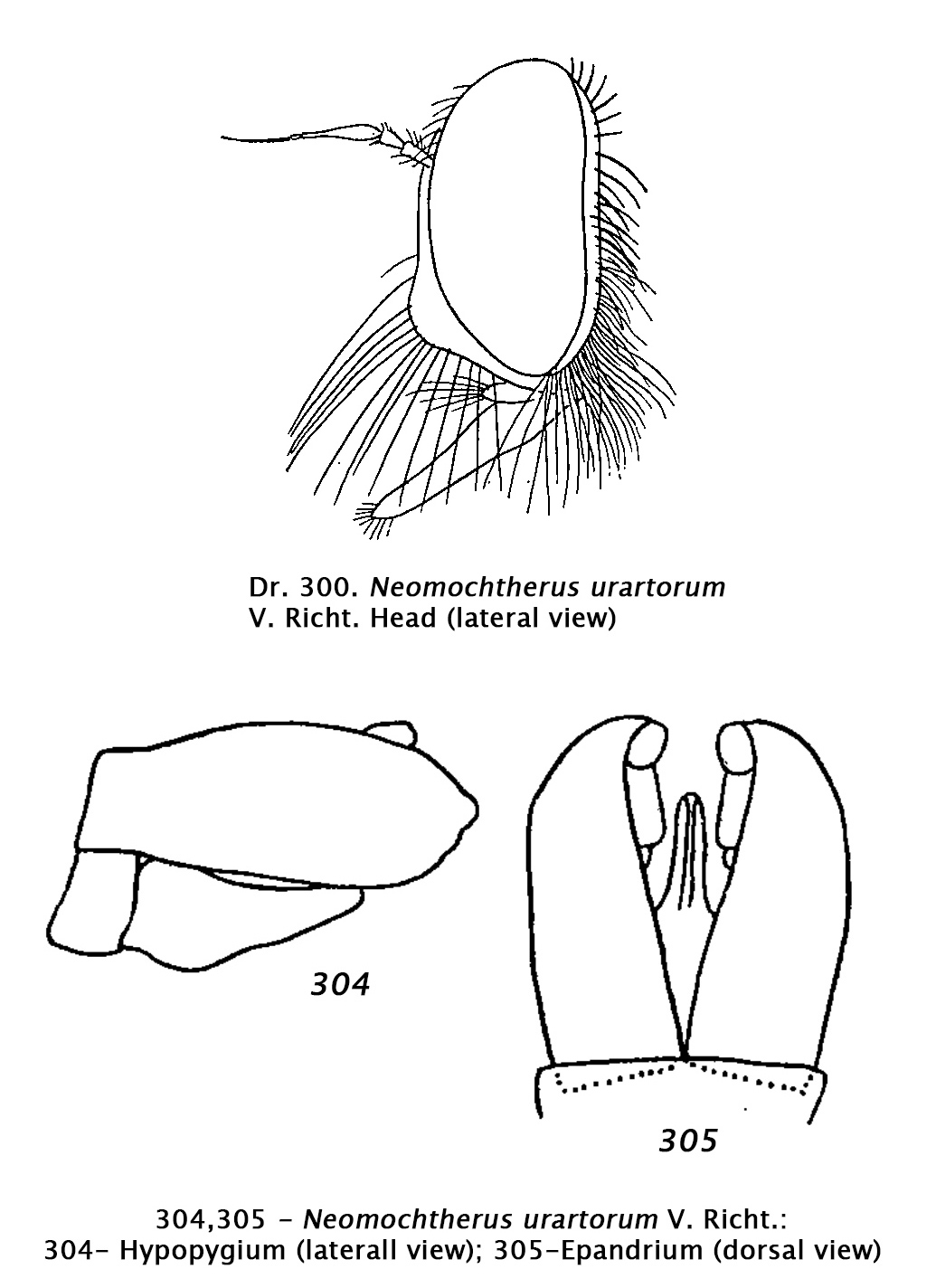 [213.48Kb] Edited by Armen Seropian on 27-07-2019 19:28 |
|
|
|
| Quaedfliegh |
Posted on 27-07-2019 20:48
|
|
Member Location: Tilburg Netherlands Posts: 2225 Joined: 18.05.10 |
Are the smaller pictures the same species? The hypopygium of the male in lateral view (https://ibb.co/5jPgX1G) looks very much like that of N. perplexus even the strange vertical "projection" of the gonopod on the ventral side is visible! (it doesn't work to copy yhe illustration from Richter 1988 (translation of older work 1969) Do you know the work by Tsacas 1968 on Neomochtherus?
Quaedfliegh attached the following image: 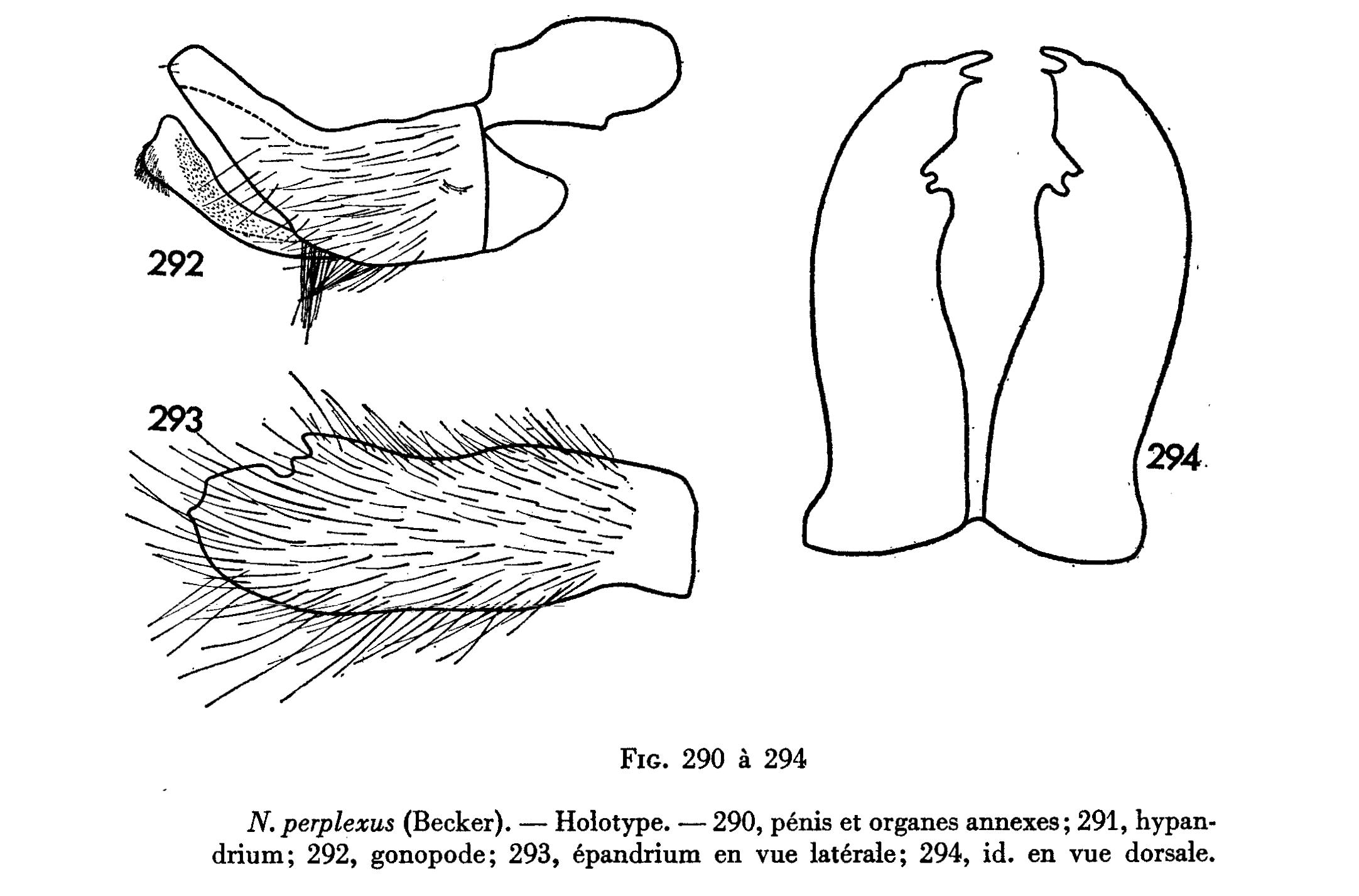 [260.46Kb] Edited by Quaedfliegh on 27-07-2019 21:09 Greetings, Reinoud Field guide to the robber flies of the Netherlands and Belgium: https://www.jeugdbondsuitgeverij.nl/product/field-guide-to-the-robberflies-of-the-netherlands-and-belgium/ https://www.nev.nl/diptera/ |
| Quaedfliegh |
Posted on 27-07-2019 21:13
|
|
Member Location: Tilburg Netherlands Posts: 2225 Joined: 18.05.10 |
Finally I found thetrick to attach.
Quaedfliegh attached the following image: 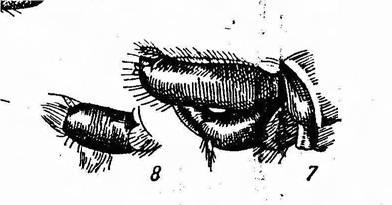 [51.46Kb] Edited by Quaedfliegh on 27-07-2019 21:14 Greetings, Reinoud Field guide to the robber flies of the Netherlands and Belgium: https://www.jeugdbondsuitgeverij.nl/product/field-guide-to-the-robberflies-of-the-netherlands-and-belgium/ https://www.nev.nl/diptera/ |
| Quaedfliegh |
Posted on 27-07-2019 21:19
|
|
Member Location: Tilburg Netherlands Posts: 2225 Joined: 18.05.10 |
Your picture partly:
Quaedfliegh attached the following image: 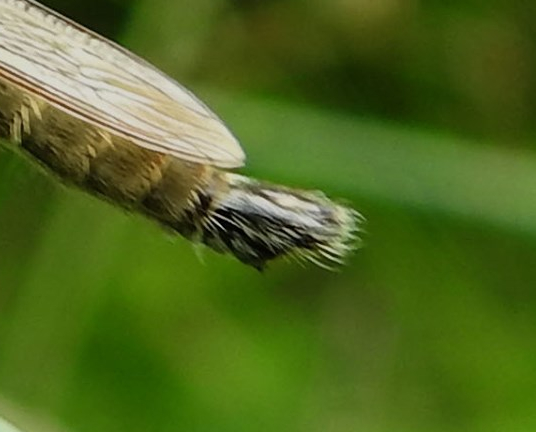 [127.77Kb] Edited by Quaedfliegh on 27-07-2019 21:20 Greetings, Reinoud Field guide to the robber flies of the Netherlands and Belgium: https://www.jeugdbondsuitgeverij.nl/product/field-guide-to-the-robberflies-of-the-netherlands-and-belgium/ https://www.nev.nl/diptera/ |
| Armen Seropian |
Posted on 28-07-2019 15:07
|
|
Member Location: Georgia, Tbilisi Posts: 391 Joined: 21.03.16 |
Hi, Reinoud! The thing is, the size doesn't match. I was told the specimen's length hardly reached 15 mm. Also the femurs seem to be completely yellow (without darkened anterior surface as is it's said in description)  Do you have any drawings of N. desertrorum hypopygium? I lean towards that species. Edited by Armen Seropian on 28-07-2019 17:03 |
|
|
|
| Quaedfliegh |
Posted on 28-07-2019 17:57
|
|
Member Location: Tilburg Netherlands Posts: 2225 Joined: 18.05.10 |
Asilidae can vary considerably in size and, according to Engel 1930 legs yellow without stripes, size 16mm. Tsacas 1968, who had seen the holotype writes that legs are yellow and gives 15,5 mm. I think that Richter described a different species! Maybe she copied Lehr of which Tsacas says that he had probably had N. hungaricus at hand. It is a pity that she didn't give a picture of the genitalia.
Greetings, Reinoud Field guide to the robber flies of the Netherlands and Belgium: https://www.jeugdbondsuitgeverij.nl/product/field-guide-to-the-robberflies-of-the-netherlands-and-belgium/ https://www.nev.nl/diptera/ |
| Armen Seropian |
Posted on 28-07-2019 19:06
|
|
Member Location: Georgia, Tbilisi Posts: 391 Joined: 21.03.16 |
Damn, this one is a headache!  Hope a friend of mine will get some better shots. Edited by Armen Seropian on 28-07-2019 19:08 |
|
|
|
| Jump to Forum: |













